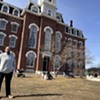Published June 5, 2013 at 9:50 a.m.
Ten years ago, Burlington education officials were considering shutting down H.O. Wheeler and Lawrence Barnes, the Old North End’s two elementary schools. Both were failing, demoralized institutions with declining enrollments and the lowest test scores among the city’s six primary schools.
Today, there’s a waiting list for the kindergarten class at both Barnes and Wheeler. Growing numbers of middle-class families from outside the Old North End are being pulled toward what are now the city’s two magnet schools. They’re attracted by the specialized focus each adopted five years ago in response to an outcry against the looming loss of twin cornerstones of neighborhood identity. The transformation has not been uniformly smooth, but the quality of education at the two schools has demonstrably improved, according to test results and the testimony of parents, teachers, administrators and students themselves.
Barnes and Wheeler, which were renamed the Sustainability Academy and the Integrated Arts Academy, respectively, now shine as success stories — in contrast to the discordant, racially fraught narrative that has spun out at Burlington High School this past academic year. There, some African immigrant students have staged protests in response to perceived instances of discrimination, prompting anguished discussions about race in a school district that is now 30 percent nonwhite.
Minority students represent close to a majority at both the sustainability and arts schools. And race relations appear mostly harmonious at both, although there were tensions as enrollment started to shift to include more white students from outside the area and as the schools underwent a radical transition in their curricula.
Moreover, standardized tests administered at elementary schools under the New England Common Assessment Program (NECAP) show an upward trajectory in reading and math results at both the Sustainability Academy and the IAA. The percentage of students scoring at the two highest levels has jumped by about 20 percentage points at each school over the past five years, while the proportion with the lowest scores is much smaller now than in the premagnet era. Attendance rates have also climbed. Vandalism has ceased.
Recent visits to both schools show them to be orderly, friendly settings where children seem glad to be.
It wasn’t always this way. A few years ago, Colby Kervick recalls, friends and colleagues would tell her, “I can’t believe you’re sending your child to Wheeler.”
An education professor at the University of Vermont, Kervick says she argued in response that the school was not as bad as its reputation and that the neighborhood was not nearly as dangerous as many outsiders imagined. Still, the skeptics had trouble understanding why Kervick did not move out of the Old North End into a “better” school district, or at least send her older child, now a seventh grader at Edmunds Middle School, to a private institution.
Kervick’s younger child is currently enrolled at the IAA. And she notices that the parents of some of her daughter’s playmates have chosen that school over another closer to their homes.
“It used to be a hidden treasure,” Kervick says of Wheeler. “I guess the secret’s out. Some parents who might have sent their kids to, say, the Waldorf School are coming here for the arts curriculum — and in a public school setting.”
The magnet concept represents the opposite of the thinking that inspired proposals to close Barnes and possibly Wheeler a decade ago. Because of the two schools’ exceptionally high poverty rates and low academic achievement, some Burlington educators, including then-Superintendent Lyman Amsden, reasoned that Old North End students would fare better if integrated into the city’s other schools.
The opposing view was that socioeconomic integration could result not from sending Old North End children elsewhere, but from enticing middle-class families from outside the area to entrust their kids’ education to teachers and staff at a reincarnated Wheeler and transformed Barnes. The Burlington school board decided that an emphasis on sustainability and the arts would be potential draws for progressive-minded parents of means. Proponents of the magnet model maintained that local students, too, would benefit from innovative pedagogy that used the arts and environmental education as tools for teaching reading, writing and arithmetic.
It took a few years for the concept to gel into encouraging outcomes at Vermont’s first — and still only — magnet schools. Both schools went through traumatic turnovers of principals, cueing concerns that the new institutions were lacking a clear sense of direction and purpose. But now stable, effective leadership is making a big difference at both the academies.
Victor Prussack, magnet schools coordinator for the Burlington School District, says he’s learned from his teaching experience in California and New York City that “the strength of a principal is what most determines a school’s climate.”
Faculty and parents seem generally to agree that the current principals of the two academies demonstrate strong leadership by maintaining consistent presence in the halls, classrooms and lunchrooms and by greeting every student by name — and with a smile. “They’re not just good educators; they’re both big morale boosters,” Prussack says of IAA principal Bobby Riley and Sustainability Academy principal Brian Williams.
The former Wheeler School shuffled through three principals in four years. It’s now led by Burlington native Riley, who knows the school intimately from having worked in its library for 11 years before being given the top job. Williams, who served for a year as leader of the arts academy, succeeded a principal at the sustainability school who had resigned in 2011 amid allegations of racial insensitivity and rudderless leadership.
Williams, a former assistant principal at Burlington High School, has a personal as well as professional investment in seeing the magnet schools succeed. One of his daughters, now a middle schooler, went to the IAA; his younger child is currently enrolled at the Sustainability Academy. “I’ve got skin in this game,” Williams remarks.
Both academies still struggle with issues related to race, class and culture. Riley acknowledges that “we do have some instances of name-calling.” They’re not common, however, and not surprising, “given that the society as a whole has these problems, too,” Riley notes.
Both schools’ curricula are evolving in response to lessons learned by faculty and administrators. They struggle at times to mesh their institutions’ unique characters with the Burlington School District’s expectations for elementary-school education. Some teachers at the academies say they strive not to be stifled by public-school bureaucracy.
Riley and Williams readily acknowledge that their schools are works in progress, and that teachers and administrators are learning at least as much as the students. “Every day’s an adventure — for us as well as the kids,” says Riley — or “Mr. Bobby,” as he’s known throughout the school.
One of the challenges of both magnet schools is addressing the needs of an extraordinarily diverse population. The scene at the IAA and Sustainability Academy is “kaleidoscopic,” as Williams puts it. Twenty languages are spoken by students at the arts school; 15 by those at the sustainability school. Of the 300 students at the former, 72 percent meet the district’s definition of “poor”; at the latter, which enrolls just over 200 pupils, the corresponding figure is 79 percent. Still, both percentages are lower than in the Barnes and Wheeler days and are trending toward the district-wide average of 50 percent.
At a recent Friday afternoon “town meeting” at the arts academy, the students sitting on the gym floor represent a multitude of racial and ethnic backgrounds. A Somali girl wearing a head scarf leads the assemblage of Bhutanese, Vietnamese, Chinese, Burmese, Nepali, Sudanese, Congolese, Central American, African American and white students in a chant of “I-A-A!” to the accompaniment of a thumping hip-hop beat. It’s an orderly gathering, though. The pupils are quiet and attentive as nattily dressed visitors from the Essex Children’s Choir perform a few a cappella rounds.
There’s a similarly polychromatic picture at a recent Monday morning assembly at the Sustainability Academy. Williams is introducing a wall-projected video made by the fourth and fifth graders. They have visited some of the ethnic food stores within a quarter mile of their school on North Street: the Himalayan Food Market, Thai Phat, Brixton Halal, the Community Halal Store and Mawuhi African Market. The pupils seated in rows clap politely as the video flickers to an end.
“This is a calm place,” observes Prussack, who helps recruit students for the schools and consults on their curriculum development. “Everyone pretty much gets along, pretty much all the time.”
Cole Ives, the father of a kindergartner at the Sustainability Academy, says the school has the usual discipline issues, as well as occasional disruptions that may have to do with differences in students’ appearance. “As soon as there’s a problem, they deal with it,” Ives says of the academy’s staff. “They take care of it right away. Done. Over.”
Students and parents interviewed for this story — at random and by referral from the schools’ principals — generally agree that the academies are convivial, engaging, tolerant places. “My greatest gift to my two children is for them to come to school here,” Williams says. “What they learn at the magnet schools enables them to move seamlessly into a world of different classes, cultures and races.”
“I love it!” Maday Shegow exclaims when asked her opinion of the arts academy. The Somali refugee has four children at the school. “They are happy to be here and to have so many friends.”
Ives, who is waiting for his son, Chad, alongside an aquarium and a table topped with kiwis, bananas and a cardboard sign reading “Free Food,” adds, “This has to be one of the best schools ever. It feels like home.”
To Damber Bhandari, the IAA is “a safe place.” That quality stands out to the Bhutanese immigrant who lived in a refugee camp in Nepal for several years before coming to Burlington. Bhandari says the older of her two daughters attending the arts academy wants to be a doctor, “but first she has to learn some better English.”
Khin Lwin, a refugee from Burma who lived for several years in Thailand, says her three children at the Sustainability Academy especially enjoy their frequent field trips. “Shelburne Farms — that’s a place they like a lot. Also [North] Beach — for learning to swim,” she says.
Williams tells the sustainability school’s students at a recent assembly that a multicultural gathering such as theirs would once have been described as a “melting pot.” But that’s not really how diversity in skin color, dress and language should be seen, he continues. “It’s more a mosaic.”
Unsurprisingly, neither of the magnet schools has completely transcended the boundaries that keep many Americans separated by differences of race or class.
“Look out at the PTO meetings, and there’s just this sea of white faces,” Riley says in regard to the arts academy’s parent teacher organization. “How do we reach out more effectively? It’s still not clear.”
The same palette appears when the Sustainability Academy’s PTO convenes, notes Helen Rock, who works at Seventh Generation and sends her two children to the school. “People do go out of their way to be inclusive,” Rock says, “but we haven’t succeeded in getting parents of color involved. It’s frustrating.”
The academies host tea parties for various groups of parents on a regular basis, as part of their principals’ efforts to engender a sense of belonging in all the members of their school communities. “That’s pretty successful,” Riley says. “It can be a starting point, anyway.”
The faculty of both schools is almost entirely white. “We’ve had better success with the after-school program and paraeducators” in recruiting nonwhites, says Anne Tewksbury-Frye, who helps shape the sustainability curriculum at the former Barnes. More broadly, though, the magnet schools, like all schools in Burlington, have yet to answer a question posed by Prussack: “How do we get the demographics of the adults here to reflect the students’?”
Class differences, even more than race, generate friction among some students and parents, Riley notes. The gap between richer and poorer has a geographical element, he says. Riley offers the example of the IAA’s Halloween party, which has prompted some parents from outside the Old North End to complain about the loud music played and the junk food served. Students from the neighborhood, regardless of their color, don’t always get along well with those from more affluent parts of town, Riley adds.
Burlington parents can now choose where to send their children to elementary school, but do they know what education those children will receive? Parents may be puzzled by what, exactly, is on offer at the Sustainability Academy, its administrators acknowledge. The arts curriculum at the former Wheeler, by contrast, proved an instant hit. Tewksbury-Frye observes that the “very vibrant arts community in Burlington” has served as something of an extended faculty for the IAA.
Classroom teachers in the century-old brick building on Archibald Street are able to work with local arts specialists who offer joint instruction in music, dance, theater and visual art, Prussack says. Burlington City Arts offers hands-on learning opportunities to the school’s students, while the Vermont Arts Council assigns professional dancers, musicians and storytellers to residencies at the academy.
How do the arts get integrated in the classroom?
Aurie Thibault, a fourth-grade teacher, says he recently used the paintings of Wassily Kandinsky, a pioneering abstractionist, to enhance math lessons for his students. “We studied Kandinsky’s work and looked to see all the different kinds of angles in it,” Thibault relates. His students then tried their own hands at making similar paintings.
It’s a bit harder for Prussack, who recruits at preschools on behalf of both magnet schools, to convey the sustainability concept to parents considering sending their children to one academy or the other. Because the former Barnes is the first public elementary school in the United States to focus on such a curriculum, the school’s staff has had no template to guide its approach to learning.
“Sustainability is usually seen as environmentalism,” notes Becky Rabin, who worked at the school as a math specialist for seven years as Barnes transitioned into the Sustainability Academy. Her daughter, Cora, is now a student there. “Sustainability means more than that,” she adds, “but it’s not always easy to explain.”
The Sustainability Academy has long had a close relationship with Shelburne Farms, which assigns the equivalent of a full-time staffer to work there. Students tend a vegetable garden alongside the school building, and they regularly visit the animals at the Farms. That’s part of the “place-based” method of teaching that Williams favors for the school.
There’s a sense of urgency implicit in the effort to develop a sustainability curriculum. “When I was a child, the future of the world seemed pretty bright,” recalls Williams, a 1986 graduate of Middlebury College. “That’s not really the case any longer, with climate at a tipping point and all the other problems we’re facing. We don’t try to alarm students, but I think they get what’s going on.”
As part of their ongoing examination of racial and cultural issues, older students at the Sustainability Academy toured the recent race exhibit at the ECHO Lake Aquarium and Science Center. In another venture, earlier this year, parents and staffers fundraised to enable 10 fourth and fifth graders to fly to Philadelphia for an overnight education unit at the city’s zoo. Kindergartners from the Sustainability Academy have gone on tours of the University of Vermont, visiting dorms and eating in the student center cafeteria.
“Their sights are being raised high enough at a young age so they can see the spires of the university,” says Williams, a former English teacher at BHS.
If parents sometimes need to be convinced to commit to one of the magnet schools, faculty do not. On the rare occasions that an opening occurs at the IAA or Sustainability Academy, teachers rush to apply. Prussack points out that the arts school received 39 applications for a one-year post to replace a teacher on maternity leave. Tewksbury-Frye, who has 40 years’ experience in education, says she’s never been at a school as exciting and rewarding as the Sustainability Academy.
“Send us only your best,” Williams says he tells directors of the student-teaching program at UVM. “We need high skill sets here. Good intentions are not enough.”
Prussack believes that so far the magnet schools owe their successes primarily to a shift in the outlooks of teachers and administrators. “We have high expectations for all our students,” he says. “Previously, there were low expectations for Wheeler and Barnes students. You get what you expect.”
Some students at the magnet schools have high needs, as well. Noting the large number of children of refugees enrolled at the academies, Williams says, “It’s almost impossible to grasp the complexities of the difficulties presented by some of our students. They’ve experienced multiple traumas.”
The percentage of students enrolled in special-education classes at the academies is actually lower than the district-wide average. But, Prussack notes, “We have some extreme special needs.” About a dozen children attending the Sustainability Academy are homeless, for example.
Overall, it’s a good place to be a student, says Kaltoumaa Bulle, a Somali Bantu who’s enrolled in the fourth grade but has the poise of a mature high school student. With her first-grade nephew, Abdullahi, seated on her lap in the school’s lobby, Kaltoumaa relates what she most likes about the Sustainability Academy: “The garden, my friends, learning how to be global citizens,” she says.
Asked if there’s anything she doesn’t like about the school, Kaltoumaa pauses for a few seconds and then replies, “Yes, I think the garden should be bigger.”
The original print version of this article was headlined "Grading the Magnet Schools"
More By This Author
Speaking of Local Issues
-

At the Junction of State and Federal Law, I-91 Checkpoint Becomes Site of Legal Collision
Feb 5, 2014 -

Maple Makeover? Vermonters Discover a New Sugaring Technique
Feb 5, 2014 -

Disharmony on Prospect Street: A Dispute Between Neighbors Strikes a Sour Note
Feb 5, 2014 -

Treatment or Trial? Growing 'Rapid-Intervention' Program Gives Addicted Offenders a Choice
Jan 29, 2014 -

Raw Deal? Farmers Push Back Against Unpasteurized Milk Regulations
Jan 29, 2014 - More »
Comments
Comments are closed.
From 2014-2020, Seven Days allowed readers to comment on all stories posted on our website. While we've appreciated the suggestions and insights, right now Seven Days is prioritizing our core mission — producing high-quality, responsible local journalism — over moderating online debates between readers.
To criticize, correct or praise our reporting, please send us a letter to the editor or send us a tip. We’ll check it out and report the results.
Online comments may return when we have better tech tools for managing them. Thanks for reading.
















































